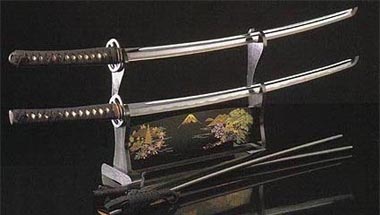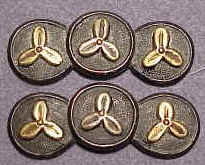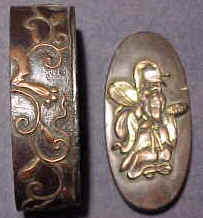
Short history
The sword, (in Japanese nihonto), has been playing a special role in the Japanese culture since many centuries. It is known since the mythological times of Shinto gods. We learn from a myth, that the goddess of Sun, Amaterasu, sent her grandson, Ninigi, with a mission, to clear out situation on mortals' Earth. She gave him some gifts for his odyssey, including a great and awesome sword that was later succeeded by the first half-mortal, half-god ruler of Japan, Jinmu. Once, he used it to get out from a high and flaming steppe. He managed to cut his way out to safety. From then on, that sword was called the Grass-Cleaver. After some time it became holy, and one of the three imperial insignias. In Japan, there always was, and there still exists a belief that a sword has a soul, and in a way, it shows what kind of a person was the blacksmith, that made it. Two main religions, Shinto and Zen Buddhism, turned this belief into a well-known fact and gave a sword remarkable and sometimes supernatural attributes. A fine sword could be made only be an impeccable man. The process of forging a sword was usually a half-religious ceremony. Many days before starting, the blacksmith-master begun meditating and taking part in ceremonies that were supposed to purify his soul and body. Next, dressed in special clothes, he said long prayers, asking Kami to help him. Actualy, he was praying all the time, while he was working with the sword. Simenawa cords protected the entrance and the hall of the smithy. They were supposed to keep away bad spirits and invite the good ones instead. After such preparations, the craftsman could start doing his job. The blacksmiths' workshop should be briefly described. The equipment used to create such a marvellous weapon was very, very simple. Large smithy forges was filled with charcoal, big hand-operated bellows, an iron or stone anvil and the needed tools, like hammers, tongs, setts and a trough filled with water. It seems impossible to create such awesome blades with so primitive tools, under those poor conditions. The process of forging differed, depending on the school and the times, when the sword was made. Blacksmith families kept their knowledge a top secret, and only the forgers' sons were allowed to know all the details of making a perfect weapon. It was the fruit of many generations' work.

Smelting process
At the beginning, blacksmiths were smelting iron on them own, using bog iron ore and iron-sand. In the fifteenth century, a few of them started using steel made by specialised workshops. In the second half of the sixteenth century, the craftsmen had to use imported steel, (mainly from Europe), since there was no bog iron ore left in Japan. Using foreign steel made the swords worse than the older ones. Watetsu steel was melted in quite primitive smelters. It was kept liquid for a long time, to purify it from unwanted elements, like sulphur or phosphorus. Such steel was poured into metal moulds and forged many times. This way the Japanese were making low carbon steel, (0.1% to 0.2% carbon), that was almost pure iron. Such material was ductile and soft, even after the hardening process. One portion was 11kg heavy. That amount of material was used to make a 1 kg blade. Each portion was split into two parts, and both were used to forge a plate. One of them was carefully carbonised, to get steel containing 1.4% carbon.
 |
Parts of sword - picture |
 |
Parts of blade - picture |
Hardening
After hardening the carbonised plate, the steel was very hard and also very brittle. Next, the hard plate was smashed into pieces. These small elements were carefully selected, by the grain coarseness. The chosen pieces were placed on the other plate. The whole thing was wrapped in paper and covered with clay. Then, the pack was put into the smithy forge and after warming up it was hammer welded. After those processes, the blacksmith received a plate that was hard from one side, and soft from the other. With that steel plate, the craftsman could begin creating weld damatsu composite. The plate was warmed up, hammer weld and again divided into two identical plates. Such a process was repeated, for an example twenty times and that is why the plate was made out of millions of micron sized layers of soft iron and hard steel, one kind after another. The blacksmith could put pieces of the smashed plate in many different ways, creating patterns or other designees, looking like grains in a piece of wood. This effect is one of the most beautiful attributes of the Japanese sword.
Adapting a sword to usage
The final touch was to adapt the sword to use, by giving it a grip and preparing a special scabbard called saya that was most usually covered with a typical for Japan kind of varnish. The grip with its ornaments, hilt and scabbard were usually done by a group of craftsmen, specialised in this matter for centuries. The grip was made out of two pieces of magnolia wood, covered with a white piece of leather, possessed from big, flat fish. Next, it was wrapped with a long, flat, silk strip, usually black or navy blue that created a pattern of blanking scrap rhombuses, through which you could see the white leather. The strip was hooked to a piece of metal ornament, called kashira. The backsides were decorated with two little flat, metal carvings called menuki, (partly covered with the stripe), that show the motives of flowers, plants, animals or people. The lowest part of the sword has a small decoration, a metal ring called fuchi. The sword's hilt, called tsuba, was made out of steel, iron or copper.
 |  |  |  |  |  | |||||
Menuki - pictures | Fuchi i kashira - pictures | |||||||||
 |  |  |  |  |  |  |  | |
Tsuby - pictures | ||||||||
Swords' classification:
According to their length:
- long swords, over 60 cm of length, called daito, since the fourteenth century the name changed into tachi, and next to katana
- medium swords, 30 cm to 60 cm length wakizashi, since the fourteenth century they were used by the samurais as a pair with daito, or as an only sword by people from the lower society groups, who were allowed to use a sword
- short sword to 30 cm tanto, used by the samurais (instead of a wakizashi) as a pair with daito, or by women and rich people, that were not samurai
Types of setting:
- ken type, used for ancient swords, usually the straight tachi with one or two cutting edges, with decorated scabbards called saya, the samurais used special tapes to tuck the swords up to their belts
- jindachizukuri style, used for old swords (from the tenth century to the sixteenth century); there are a few styles of this kind of swords, because it comes from the times, when the samurais started using just their belts for carrying swords, and the grips (callesd tsuka) were covered with silk tapes, under which menuki decorations were put
- bukezukuri style, typical for the new swords (that were carried with the use of an obi belt), with wrapped grips; the swords' scabbard contained specially designed compartments, containing small daggers called kozuki and big, long kogai pin that was used for improving the hair-do, and sometimes a pair of decorated chop-sticks. Kogai were most commonly installed in wakizashi scabbards.
- shirasaya style ( style of the white scabbard), used to substitute a damaged or a lost set of a grip and scabbard and to protect the blade from damage. It was made with undecorated wood, usually without ornaments or a hilt.
- gunto type swords (military swords) are divided into two groups: old kyugunto and new shingunto (because they were mass produced, they are not classified)
- shikomezue - staff-swords (cheep, looking like little bent staffs)




